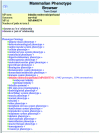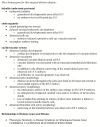The Mammalian Phenotype Ontology as a tool for annotating, analyzing and comparing phenotypic information
- PMID: 15642099
- PMCID: PMC549068
- DOI: 10.1186/gb-2004-6-1-r7
The Mammalian Phenotype Ontology as a tool for annotating, analyzing and comparing phenotypic information
Abstract
The Mammalian Phenotype (MP) Ontology enables robust annotation of mammalian phenotypes in the context of mutations, quantitative trait loci and strains that are used as models of human biology and disease. The MP Ontology supports different levels and richness of phenotypic knowledge and flexible annotations to individual genotypes. It continues to develop dynamically via collaborative input from research groups, mutagenesis consortia, and biological domain experts. The MP Ontology is currently used by the Mouse Genome Database and Rat Genome Database to represent phenotypic data.
Figures


Similar articles
-
Mouse SNP Miner: an annotated database of mouse functional single nucleotide polymorphisms.BMC Genomics. 2007 Jan 21;8:24. doi: 10.1186/1471-2164-8-24. BMC Genomics. 2007. PMID: 17239255 Free PMC article.
-
The human phenotype ontology.Clin Genet. 2010 Jun;77(6):525-34. doi: 10.1111/j.1399-0004.2010.01436.x. Epub 2010 Feb 11. Clin Genet. 2010. PMID: 20412080 Review.
-
Methods for gene ontology annotation.Methods Mol Biol. 2007;406:495-520. doi: 10.1007/978-1-59745-535-0_24. Methods Mol Biol. 2007. PMID: 18287709
-
The Sequence Ontology: a tool for the unification of genome annotations.Genome Biol. 2005;6(5):R44. doi: 10.1186/gb-2005-6-5-r44. Epub 2005 Apr 29. Genome Biol. 2005. PMID: 15892872 Free PMC article.
-
The mammalian phenotype ontology: enabling robust annotation and comparative analysis.Wiley Interdiscip Rev Syst Biol Med. 2009 Nov-Dec;1(3):390-399. doi: 10.1002/wsbm.44. Wiley Interdiscip Rev Syst Biol Med. 2009. PMID: 20052305 Free PMC article. Review.
Cited by
-
Bioinformatics for spermatogenesis: annotation of male reproduction based on proteomics.Asian J Androl. 2013 Sep;15(5):594-602. doi: 10.1038/aja.2013.67. Epub 2013 Jul 15. Asian J Androl. 2013. PMID: 23852026 Free PMC article. Review.
-
Rat Genome Database: a unique resource for rat, human, and mouse quantitative trait locus data.Physiol Genomics. 2013 Sep 16;45(18):809-16. doi: 10.1152/physiolgenomics.00065.2013. Epub 2013 Jul 23. Physiol Genomics. 2013. PMID: 23881287 Free PMC article.
-
Mouse Genome Database: From sequence to phenotypes and disease models.Genesis. 2015 Aug;53(8):458-73. doi: 10.1002/dvg.22874. Epub 2015 Jul 27. Genesis. 2015. PMID: 26150326 Free PMC article. Review.
-
PhenoMiner: quantitative phenotype curation at the rat genome database.Database (Oxford). 2013 Apr 19;2013:bat015. doi: 10.1093/database/bat015. Print 2013. Database (Oxford). 2013. PMID: 23603846 Free PMC article.
-
Commentary: mouse genetic nomenclature. Standardization of strain, gene, and protein symbols.Vet Pathol. 2010 Nov;47(6):1100-4. doi: 10.1177/0300985810374837. Epub 2010 Aug 4. Vet Pathol. 2010. PMID: 20685919 Free PMC article.
References
-
- MGI_3.01 - Mouse Genome Informatics http://www.informatics.jax.org
MeSH terms
LinkOut - more resources
Full Text Sources

